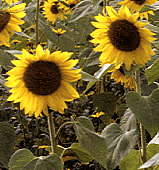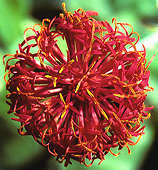|
The Asterales is an order of flowering plants with 11 families including 25,000 species of Asteraceae or Compositae (daisies, thistles, sunflowers) characterised by their composite flowers formed from many florets and 2000 species of Campanulaceae (bell flowers). Asterales are widely distributed thoughout most of the world and are usually herbaceous plants with a few shrubs and giant tree-like members.
Common characteristics include unique stamen morphology, with stamens usually aggregated densely around the style or fused into a concentric tube. Within the Asterales the oligosaccharide storage molecule inulin replaces starch.
Within the Asterales are economically important food crops e.g. Helianthus annuus (sunflower),
Lactuca sativa (lettuce), Cichorium sp. (chicory), Cynara cardunculus var. scolymus (globe artichoke). The Order also includes spices, flavourings and medicinal herbs. The aromatic shrub Artemisia absinthium contains thujone, a traditional ingredient in the bitter liqueur Absinthe. Tussilago farfara (Coltsfoot) is a traditional cough suppressant in the form of Coltsfoot candy and syrup.
Many of the Asteraceae (e.g. chrysanthemum, dahlia) and Campanulaceae (Bell Flowers) are common in gardens.
The genus Chrysanthemum includes species that make the natural insecticide Pyrethrum that has been used in Eastern Europe and Asia for hundreds of years to discourage fleas and lice, and was the basis for Keating's Powder. Tagetes (marigolds) release terpenoid compounds, killing parasitic nematodes in the soil and discouraging other pests, so are often grown as companion plants to food crops.
Succulent Asteraceae are found mainly in the genera Othonna, and Senecio and include many popular, easily cultivated succulent plants. Many species of Senecio, including succulents, contain toxic Pyrrolizidine alkaloids and must not be ingested or used as fodder.
Brighamia insignis from the Hawaiian islands represents the only truly succulent genus (Brighamia) in the Campanulaceae.
|

 Families of Succulent Plants
Families of Succulent Plants 






